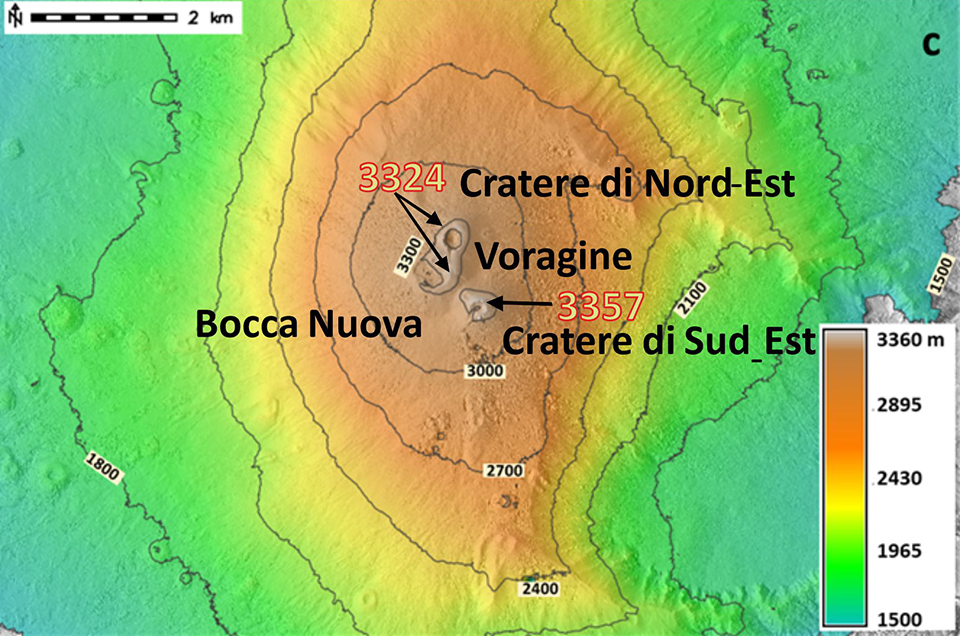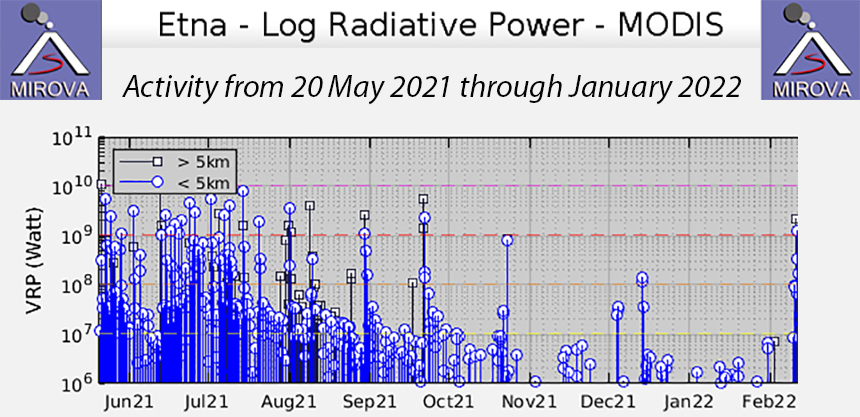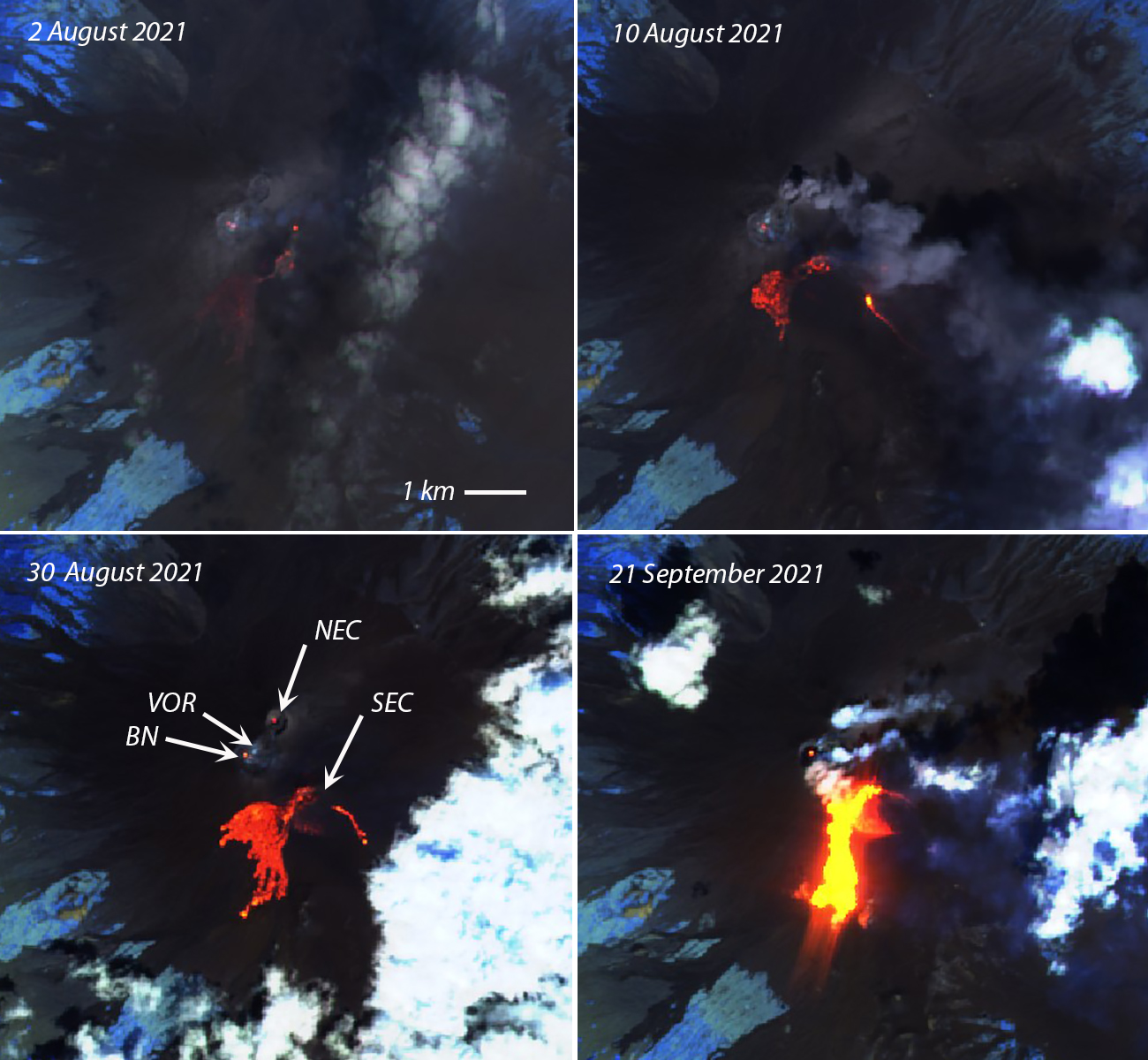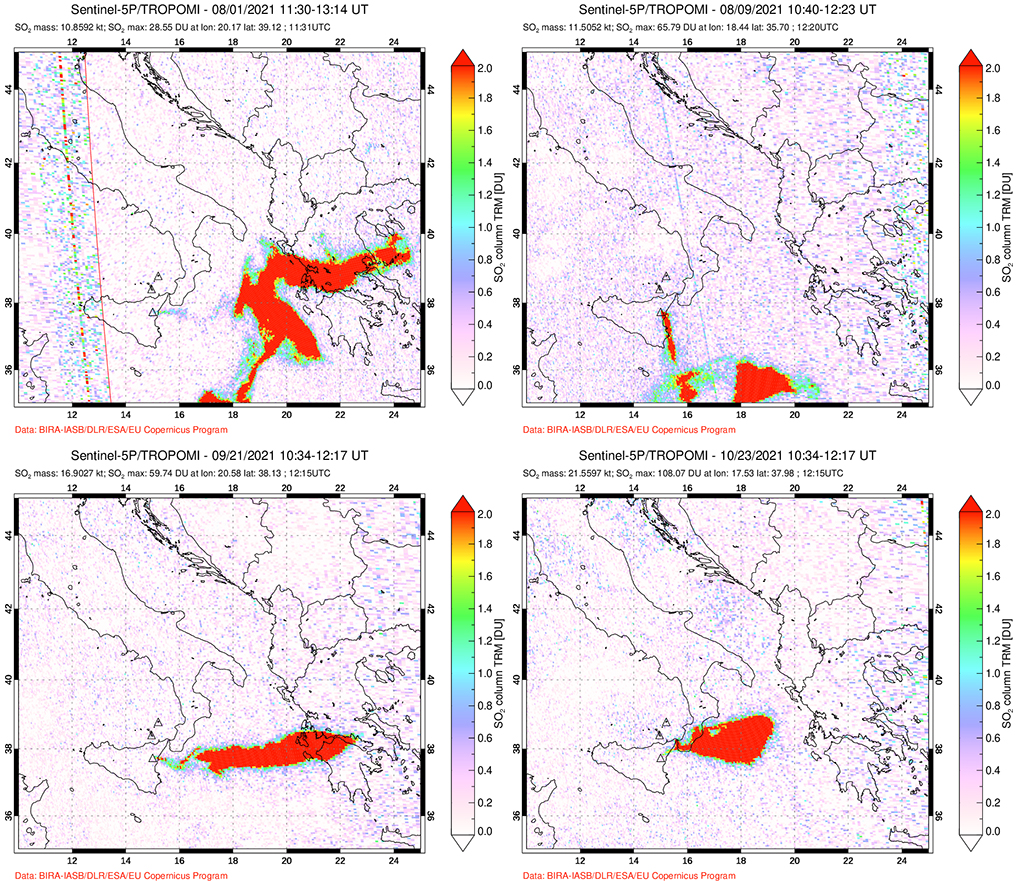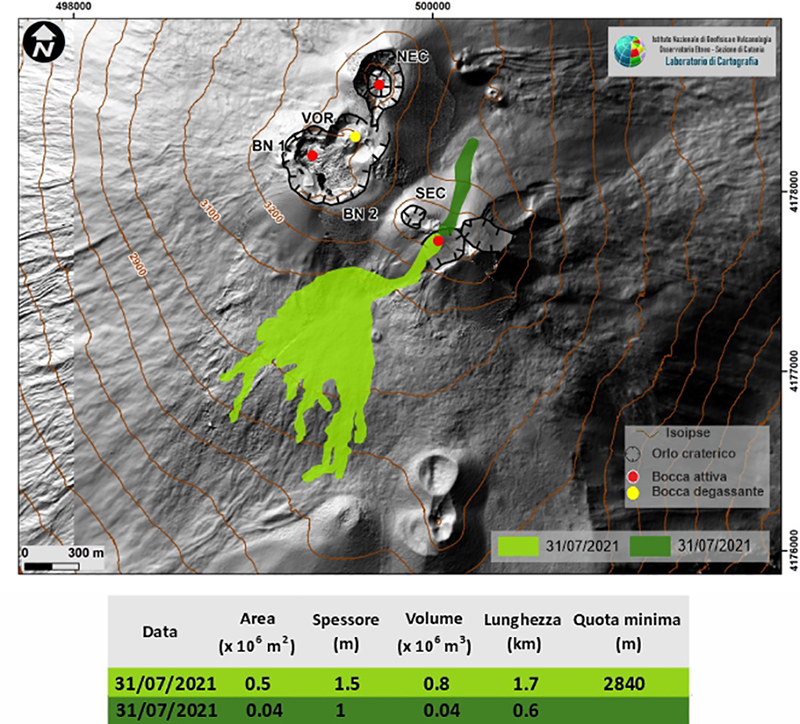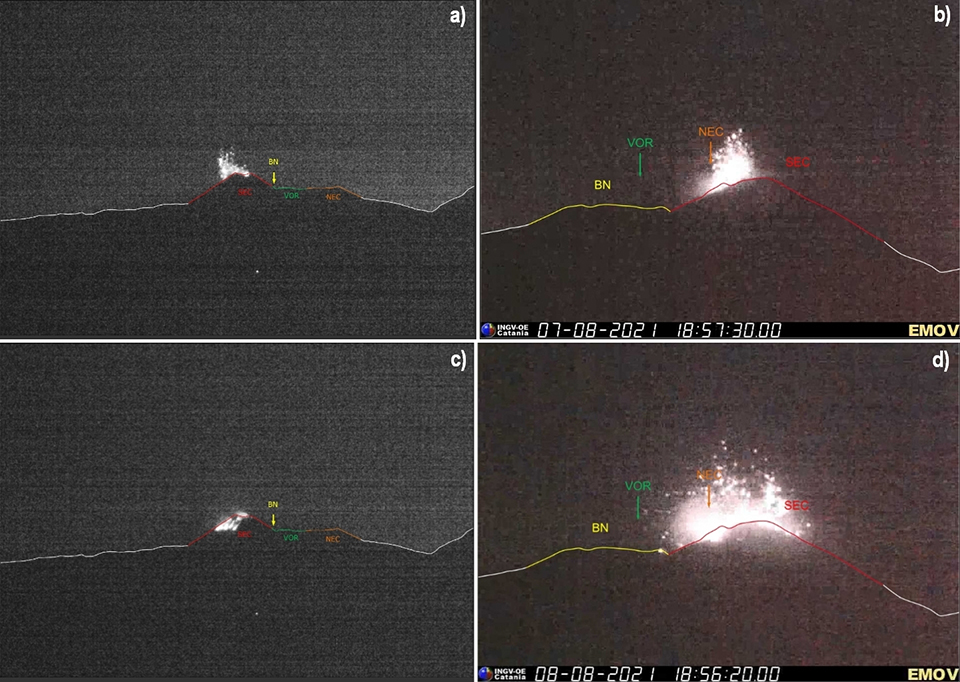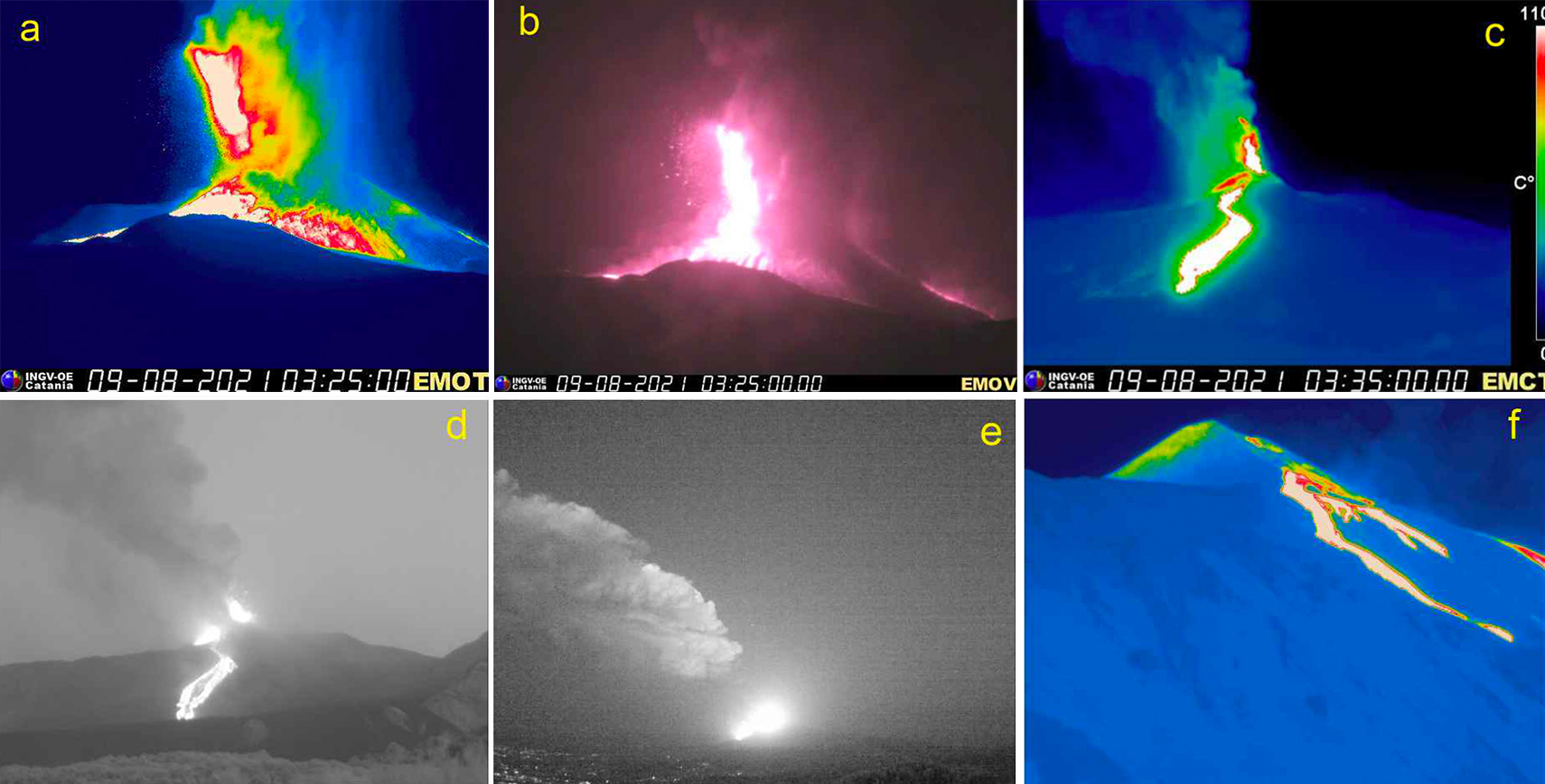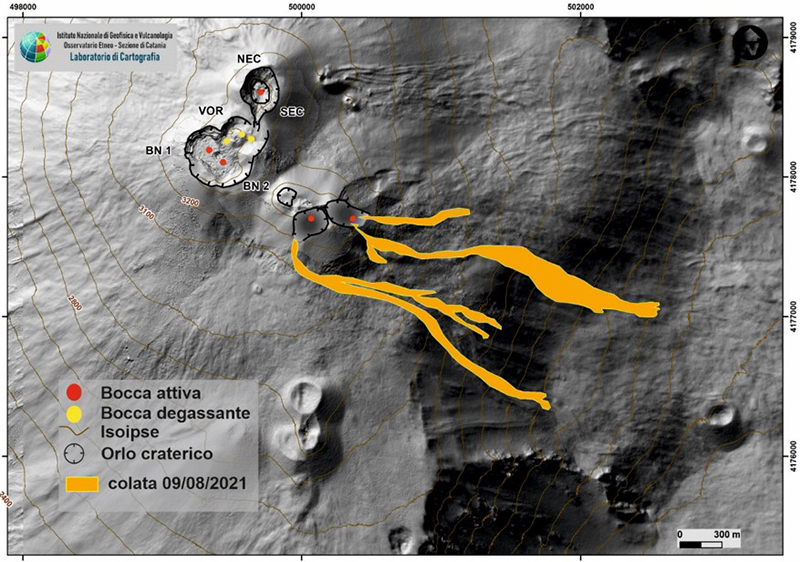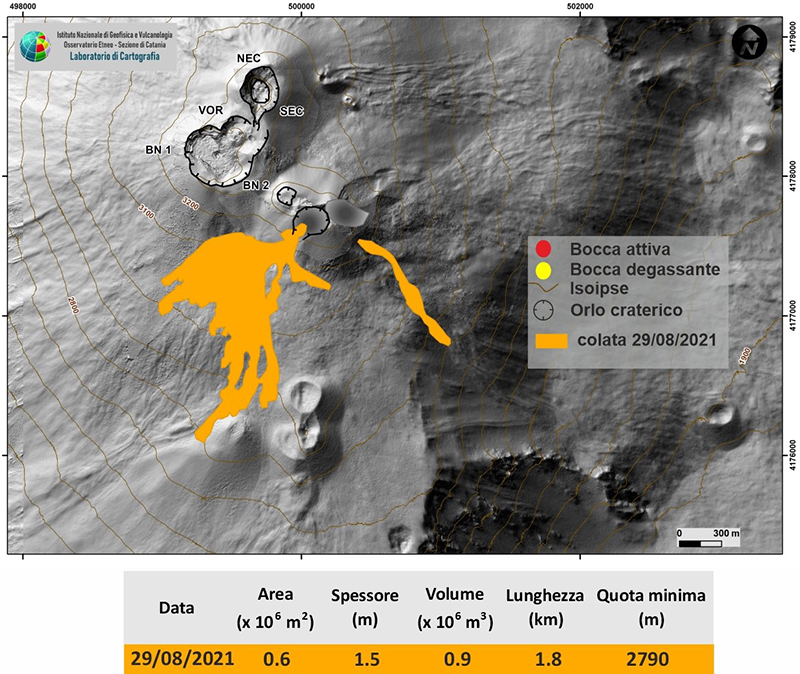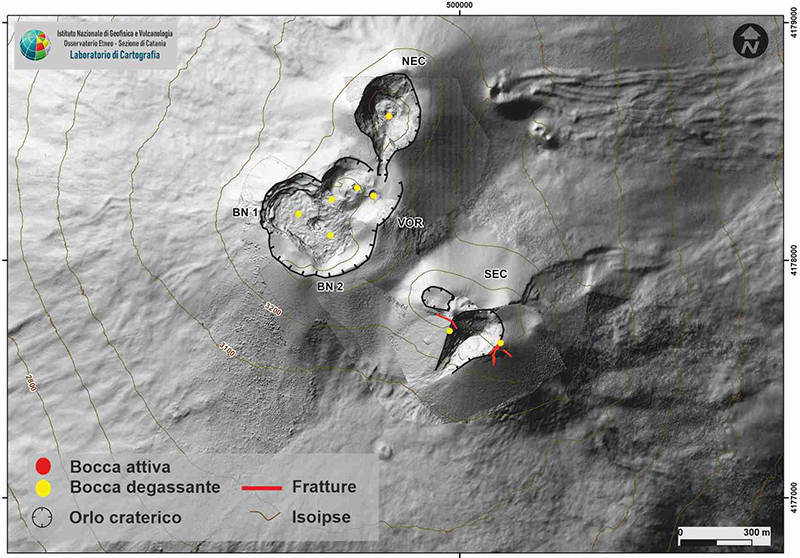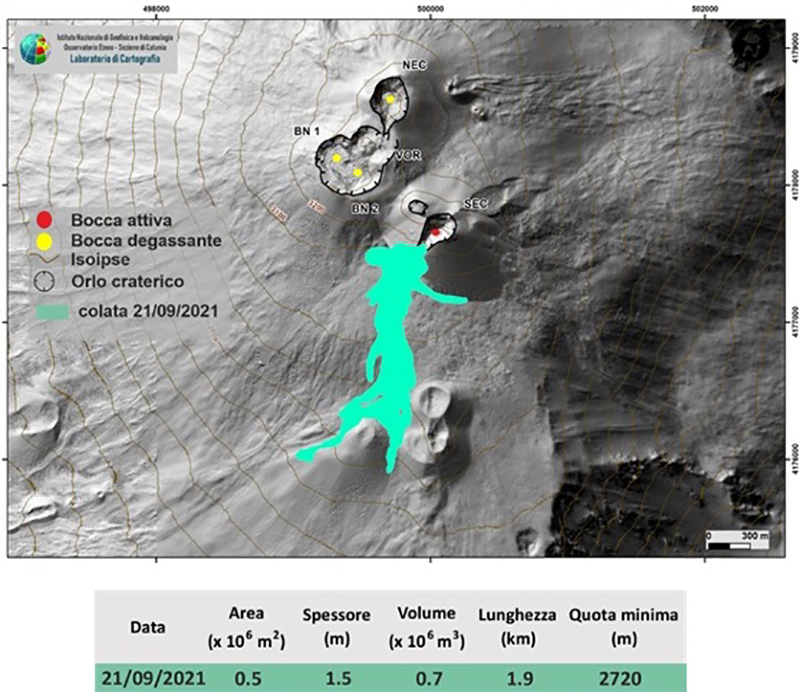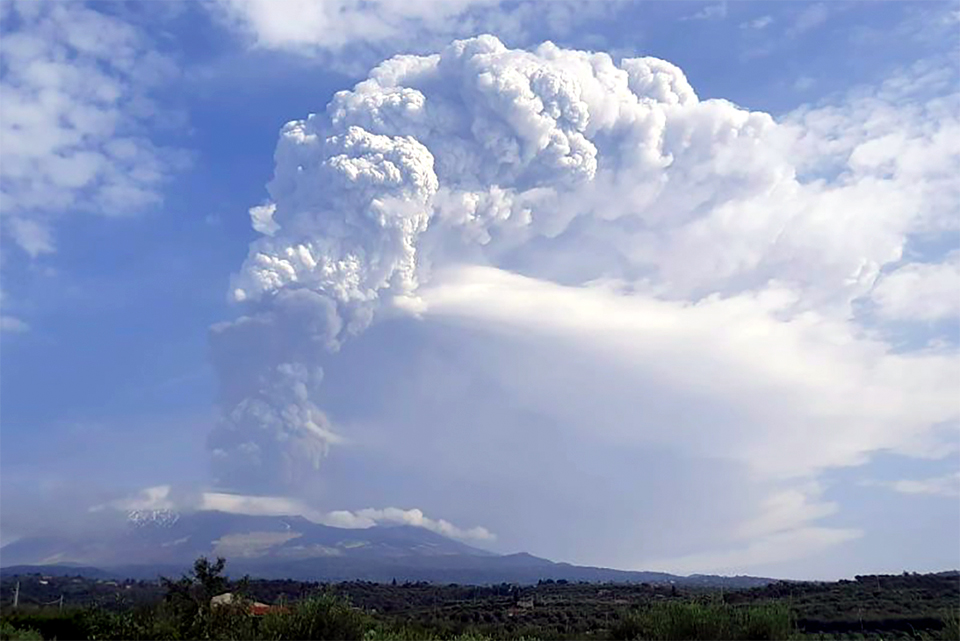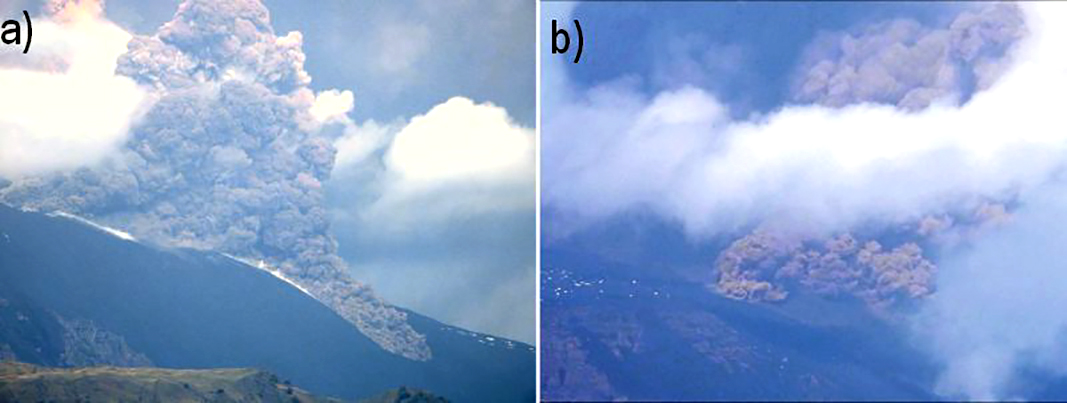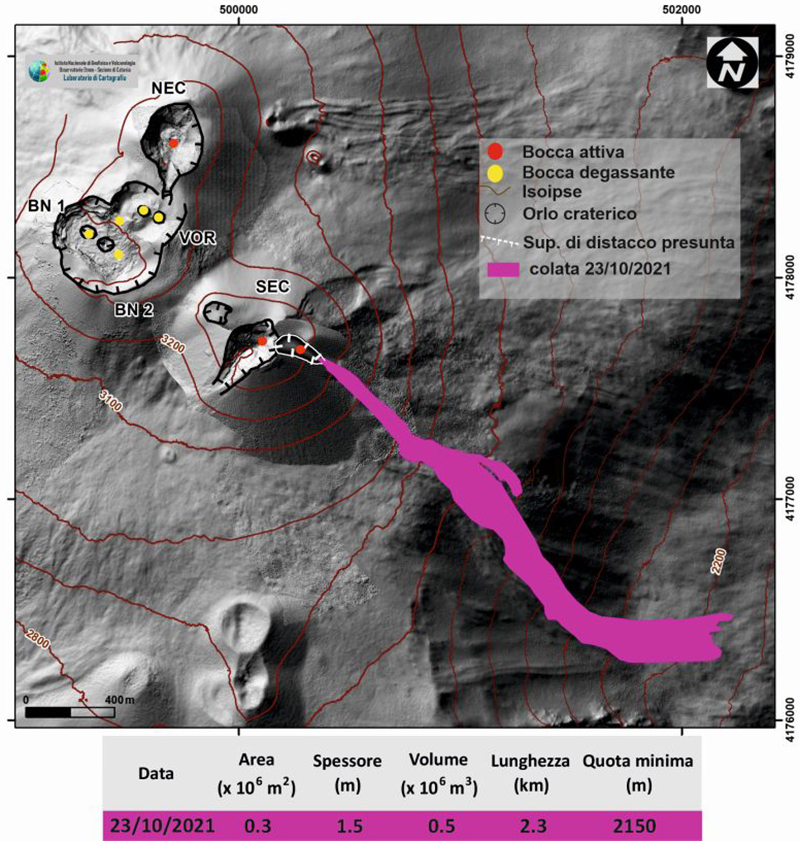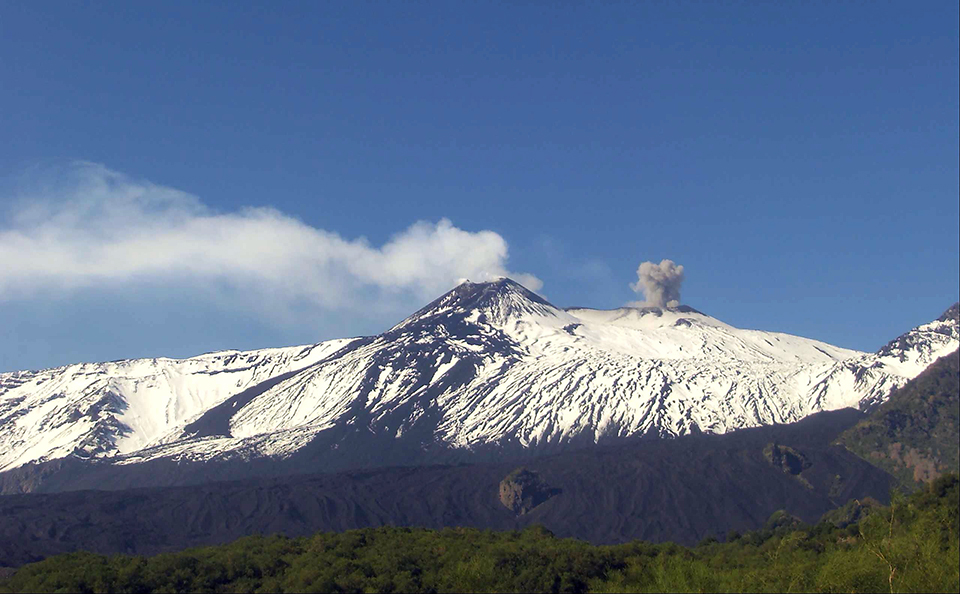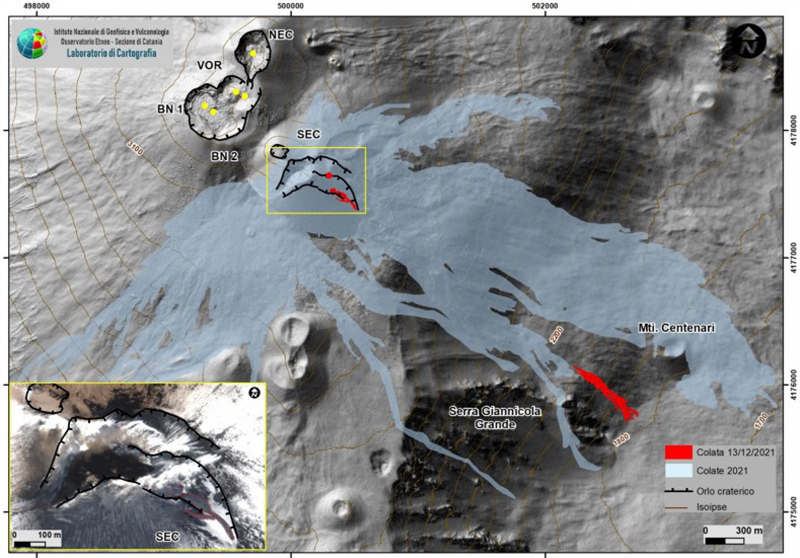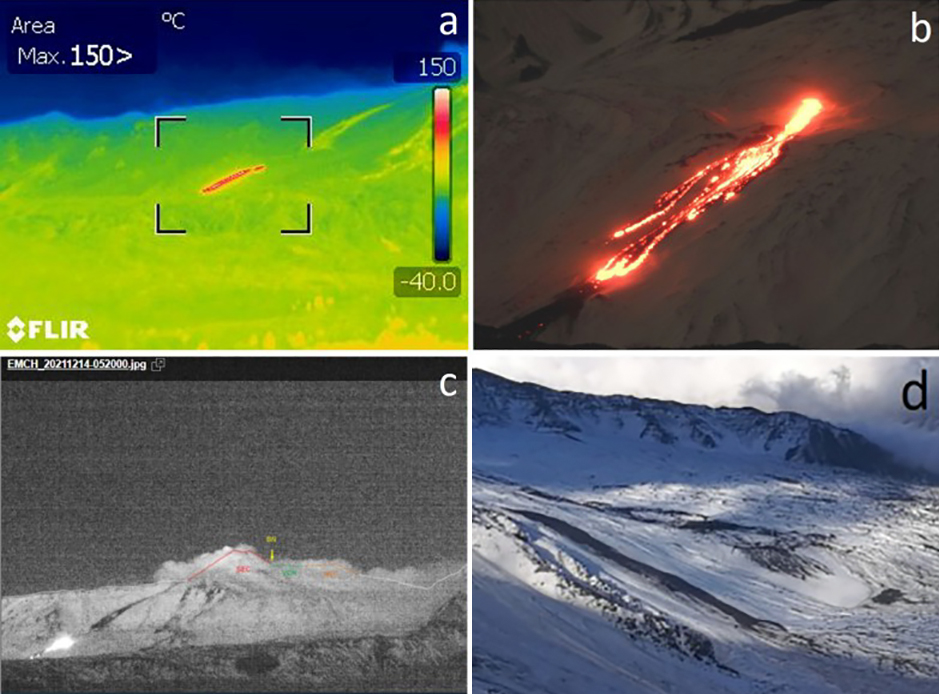Report on Etna (Italy) — March 2022
Bulletin of the Global Volcanism Network, vol. 47, no. 3 (March 2022)
Managing Editor: Edward Venzke.
Edited by A. Elizabeth Crafford.
Etna (Italy) Strombolian activity, ash emissions to 10 km altitude, and lava flows at SEC through January 2022
Please cite this report as:
Global Volcanism Program, 2022. Report on Etna (Italy) (Crafford, A.E., and Venzke, E., eds.). Bulletin of the Global Volcanism Network, 47:3. Smithsonian Institution. https://doi.org/10.5479/si.GVP.BGVN202203-211060
Etna
Italy
37.748°N, 14.999°E; summit elev. 3357 m
All times are local (unless otherwise noted)
Etna, located on the Italian island of Sicily, has documented records of eruptions dating back to 1500 BCE. Activity has frequently originated from its multi-cone summit where several craters have formed and evolved over decades. The current configuration consists of the Northeast Crater (NEC), the Voragine (VOR) and Bocca Nuova (BN) craters that were formerly the ‘Central’ crater, and the Southeast crater (SEC). The original Southeast crater formed in 1978, and a second eruptive site formed on its SE flank in 2011 was named the New Southeast Crater (NSEC). Another eruptive site between these two was referred to as the "cono della sella" (saddle cone) and developed during early 2017. Continued activity at both NSEC and the saddle cone created a larger new multi-vent crater area adjacent to the original SEC summit crater, and the whole area is again referred to as SEC (BGVN 46:08, figure 343). The numerous eruptive episodes at SEC during 2021 have gradually but significantly changed the shape of the cone; a new digital terrain model was created on 25 July 2021 that indicates that the highest point on the volcano is now the northern rim of the Southeast crater at 3,357 ± 3 m, replacing the former summit which was the rim of NEC (figure 349).
Etna’s current eruptive period began in September 2013 and has recently been characterized by Strombolian explosions, ash plumes, lava fountaining, pyroclastic flows, and lava flows associated primarily with the Southeast crater (SEC). This report covers ongoing activity from August 2021 through January 2022, based on weekly and special reports by the Osservatorio Etneo (OE), part of the Catania Branch of Italy's Istituo Nazionale di Geofisica e Vulcanologica (INGV) and satellite data.
Summary of activity during August 2021-January 2022. Most of the activity during August 2021-January 2022 occurred in the vicinity of the Southeast Crater (SEC) cone. Persistent degassing from fumaroles and vents at Bocca Nuova (BN), Voragine (VOR), and Northeast Crater (NEC) were accompanied by occasional diffuse ash emissions (table 11). Explosions, Strombolian activity, lava fountains, and pyroclastic flows continued to reshape the SEC summit into a large interconnected multi-crater area. Multiple lava flows, recurring Strombolian activity, and a lava jet were observed at SEC during 31 July-1 August, 7-10 August, and 27-30 August. Lava fountaining, dense ash plumes, and lava flows on the SW flank were observed at SEC on 21 September. During 20-23 October activity at SEC included an 800-m-high lava fountain, Strombolian activity, 10-km-high ash emissions, and a lava flow. Strombolian activity and ash emissions were reported again from SEC during 4-8 and 14-15 December, and two lava flows emerged from a vent several kilometers E in the Valle de Bove during 13-15 December.
Table 11. Summary of activity at the four primary crater areas at the summit of Etna during August 2021-January 2022. Information is from INGV weekly reports.
| Month | Bocca Nuova (BN) | Voragine (VOR) | Northeast Crater (NEC) | Southeast Crater (SEC) | Other Activity |
| Aug 2021 | Pulsating, discontinuous degassing from both vents, BN-1 and BN-2 | Degassing from fumaroles around the crater rim | Degassing, Isolated reddish brown ash emissions, plumes reach 6 km on 4-5 and 10 Aug | Intense degassing; Two lava flows 31 Jul-1 Aug; Repeated episodes of Strombolian activity 7-10 Aug, three lava flows to E 9-10 Aug; Strombolian activity 27-30 Aug; 400 m high lava jet on 29 Aug; two lava flows to E, SW 27-29 Aug | Ashfall between Lavinaio and Zafferana, and Acireale and Pozzillo, and in Milo, Fornazzo, San Alfio,and Giarre |
| Sep 2021 | Pulsating, discontinuous degassing from both vents, BN-1 and BN-2 | Degassing from fumaroles around the crater rim | Fumarolic degassing | Lava fountaining 21 Sep, ash plume to 8 km, lava flow on S flank flows SW | Ashfall in Zafferana, Milo, Fornazzo, Riposto, Giarre and Mascali from 21 Sep event |
| Oct 2021 | Both pulsating and continuous degassing and sporadic ash emission | Fumarolic degassing | Fumarolic degassing, rare dilute ash emissions | Continuous fumarolic degassing on E rim; Strombolian explosions and lava fountain 800 m high, ash emissions to 10 km altitude and lava flow 20-23 Oct | Ash and lapilli in the communities around Vena, Presa, Piedimonte Etneo, Taormina and as far as the province of Reggio Calabria. |
| Nov 2021 | Degassing mostly from vent BN-1 | Degassing from fumaroles around the crater rim | Degassing; explosions with dilute ash emissions on 20 Nov | Degassing around the crater rim; sporadic and dilute ash emissions | -- |
| Dec 2021 | Degassing and discontinuous, dilute reddish ash emissions | Weak degassing from fumaroles around the crater rim | Degassing; dilute and discontinuous red ash emissions during first and last weeks | Degassing from fumaroles around the crater rim; Strombolian activity and ash emissions 4-8, 14-15 Dec | Two vents opened with lava flows, W wall of Valle de Bove, 13-15 Dec; Ashfall affected the S flank of the volcano and was reported as far as Capo Passero |
| Jan 2022 | Degassing; sporadic and dilute pulsating reddish ash emissions | Weak degassing from fumaroles | Degassing; dilute ash emission 16 Jan | Weak degassing from fumaroles; discontinuous Strombolian activity and dilute ash emissions | -- |
Increases in satellite thermal anomaly power correlated closely with observations of lava flows and/or Strombolian activity. MODVOLC thermal alerts were issued during 1-3, 10, and 30-31 August, 2 and 21 September, 23 October, and 4-5 and 14 December 2021. MIROVA log radiative power data from 20 May 2021 through January 2022 showed pulses of high or very high energy during those same intervals (figure 350). Sentinel-2 satellite imagery captured large thermal anomalies that corresponded to lava flows during August and September (figure 351). Major explosive and lava flow events from SEC in August, September, and October were followed by large SO2 plumes recorded by the TROPOMI Instrument on the Sentinel-5P satellite (figure 352).
Activity during August 2021. Explosions at SEC on 28 and 31 July 2021 produced Strombolian activity and ash emissions that drifted SE and produced ashfall in Fornazzo and Milo (BGVN 46:08, figure 348). The Toulouse VAAC reported a large SO2 plume drifting NE between Italy and Greece at 6-9 km altitude on 1 August. Late on 31 July two lava flows emerged from SEC and were active for about two hours on the flanks of the SEC cone; one flowed N to 2,900 m elevation and the other flowed SE to about 2,840 m elevation (figure 353). The Toulouse VAAC reported an ash plume drifting NE on 4 August at 6.1 km altitude. On 7 and 8 August 2021 Strombolian activity resumed at SEC with periodic explosions sending incandescent ejecta beyond the crater rim, and ash emissions that drifted SE at 4.3 km altitude (figure 354).
In the early hours of 9 August Strombolian activity at SEC grew into a lava flow from the eastern vent that moved E along the western wall of Valle de Bove (figure 355). A second lava flow that headed SW started about one hour later. A third lava flow then emerged from a vent at the SE base of the SEC cone. Ash emissions from the activity drifted SE at 9 km altitude and affected the towns between Lavinaio and Zafferana as far up the coast to Acireale and Pozzillo. It was visible up to 150 km ESE before it dissipated. The lava flows reached 2,900 m elevation and had ceased by the next day (figure 356). On 10 August a dense reddish ash plume from NEC rose to 6 km altitude and drifted E, causing ashfall in Zafferana.
A series of explosions began at SEC on 27 August 2021 and produced intermittent ash plumes that drifted E (figure 357). Strombolian activity resumed on the afternoon of 29 August; jets of lava rose 400 m and produced an ash plume that rose to 10 km altitude. Two lava flows emerged; one traveled ESE into the Valle de Bove from a vent at the base of the SEC cone and the other headed SW in the direction of Monte Frumento Supino (figure 358). Ash and lapilli fell in the towns of Fornazzo, Milo, San Alfio, and Giarre to the E. Weak Strombolian activity recurred on 30 August at SEC, and the SO2 plume from the previous days explosions was clearly visible in satellite data over Greece, drifting E.
Activity during September 2021. Degassing from fumaroles and vents was observed at all of the summit craters. During a site visit on 16 September 2021, drone imagery of the SEC cone revealed fractures trending NNW-SSE and NS on the rim of the crater (figure 359). After several weeks of quiet, a lava fountain appeared at SEC on 21 September. The early morning activity started as Strombolian activity and increased to a lava fountain that lasted for about 90 minutes. The lava flow spread across the southern flank of the cone in a SW direction, flowing in a channel between Mount Barbagallo and Mount Frumento Supino (figure 360), reaching an elevation of about 2,720 m. The ash cloud rose to 8 km altitude and drifted E with lapilli and ash affecting Zafferana, Milo, Fornazzo, Riposto, Giarre, and Mascali.
Activity during October-November 2021. During a field inspection on 4 October by INGV personnel, drone images showed a deepening of the SW and E edges of the SEC. Rare, small ash emissions were observed from NEC during the second week of the month. Weak Strombolian activity resumed at SEC in the morning of 20 October. Sporadic explosions were accompanied by small ash and gas plumes that drifted SW. Activity increased in the afternoon on 21 October, with explosions sending ejecta beyond the crater rim, and discontinuous ash emissions drifting E. During the evening of 22 October activity intensified further with increasing ash emissions into the morning of 23 October when several very strong explosions were followed by a lava fountain which reach as high as 800 m and produced an ash plume that rose to 10 km altitude and drifted ENE (figure 361). Pyroclastic material fell in that direction on the communities around Vena, Presa, Piedimonte Etneo, Taormina, and as far as the province of Reggio Calabria. Shortly after the explosions a pyroclastic flow occurred on the E flank of the SEC cone where it traveled 1.5 km down the western wall of Valle de Bove (figure 362). About one hour later there was a second pyroclastic flow of similar size; this was followed by several smaller flows including one that split into two branches with one moving S and one SE, traveling a few hundred meters.
The pyroclastic flows emerged from a new collapse area that extended E from the existing crater at SEC. A lava flow emerged from the eastern edge of this opening and traveled E down the western slope of Valle de Bove to an elevation of 2,150 m (figure 363). Lava fountaining ended mid-morning on 23 October; the lava flow ceased being fed that evening (figure 364). Cloudy weather prevented observations during most of the last week of the month, but during 27-28 October small ash emissions were observed from SEC from two separate emission points. During the first week of November, sporadic dilute ash emissions were observed from SEC. Explosions with dilute ash emissions were observed from NEC on 20 November 2021 (figure 365). Degassing from fumaroles and vents continued from the other crater areas.
Activity during December 2021-January 2022. Diffuse and discontinuous ash emissions were observed at NEC on 1 December, and ash dispersed rapidly near the summit. On the morning of 4 December sporadic ash emissions were observed at SEC by both INGV field personnel and webcams. During that afternoon, Strombolian activity was visible at SEC in the webcams, and continued through 8 December along with sporadic ash emissions that drifted ENE. On the afternoon of 13 December, a lava flow emerged from a vent low in the western wall of the Valle de Bove at an elevation of about 2,100 m, immediately north of the Serra Giannicola Grande (figure 366). A secondary vent opened a few tens of meters below the first one. The two vents fed a small flow which was active until early on 15 December. The flow traveled 600 m SE and reached the base of the Valle de Bove at about 1,820 m elevation (figure 367).
On the morning of 14 December 2021 Strombolian activity started at SEC accompanied by dense, fine-grained reddish ash that rose to 7 km altitude and drifted S. Ash emission continued in pulses through early on 15 December. Ashfall affected the southern flank of the volcano and was reported as far as Capo Passero. A small deposit of unconsolidated debris, about 250 m long, was visible in satellite imagery in the depression formed near the SEC summit from the 23 October 2021 activity (figure 366). This material was partially remobilized during the Strombolian activity of 14 December. Diffuse and discontinuous emissions of reddish ash were observed from BN and NEC during the second half of December (figure 368), and from NEC on 16 January 2022. Weak Strombolian activity resumed at SEC on 30-31 January with diffuse ash emissions quickly dispersing near the summit area.
Geological Summary. Mount Etna, towering above Catania on the island of Sicily, has one of the world's longest documented records of volcanism, dating back to 1500 BCE. Historical lava flows of basaltic composition cover much of the surface of this massive volcano, whose edifice is the highest and most voluminous in Italy. The Mongibello stratovolcano, truncated by several small calderas, was constructed during the late Pleistocene and Holocene over an older shield volcano. The most prominent morphological feature of Etna is the Valle del Bove, a 5 x 10 km caldera open to the east. Two styles of eruptive activity typically occur, sometimes simultaneously. Persistent explosive eruptions, sometimes with minor lava emissions, take place from one or more summit craters. Flank vents, typically with higher effusion rates, are less frequently active and originate from fissures that open progressively downward from near the summit (usually accompanied by Strombolian eruptions at the upper end). Cinder cones are commonly constructed over the vents of lower-flank lava flows. Lava flows extend to the foot of the volcano on all sides and have reached the sea over a broad area on the SE flank.
Information Contacts: Sezione di Catania - Osservatorio Etneo, Istituto Nazionale di Geofisica e Vulcanologia (INGV), Sezione di Catania, Piazza Roma 2, 95123 Catania, Italy (URL: http://www.ct.ingv.it/it/ ); MIROVA (Middle InfraRed Observation of Volcanic Activity), a collaborative project between the Universities of Turin and Florence (Italy) supported by the Centre for Volcanic Risk of the Italian Civil Protection Department (URL: http://www.mirovaweb.it/); Hawai'i Institute of Geophysics and Planetology (HIGP) - MODVOLC Thermal Alerts System, School of Ocean and Earth Science and Technology (SOEST), Univ. of Hawai'i, 2525 Correa Road, Honolulu, HI 96822, USA (URL: http://modis.higp.hawaii.edu/); Sentinel Hub Playground (URL: https://www.sentinel-hub.com/explore/sentinel-playground); NASA Global Sulfur Dioxide Monitoring Page, Atmospheric Chemistry and Dynamics Laboratory, NASA Goddard Space Flight Center (NASA/GSFC), 8800 Greenbelt Road, Goddard MD 20771, USA (URL: https://so2.gsfc.nasa.gov/).


